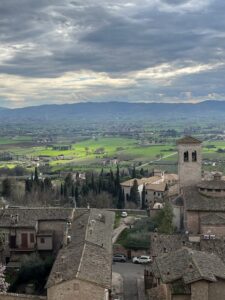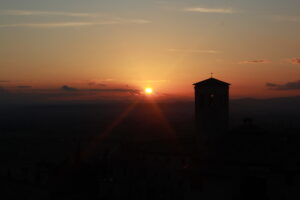I’ve preached about God’s love for Creation for over 35 years, so – as you might guess – this is a topic dear to my heart. I don’t know what questions about preaching you bring to today’s discussion, but here are several questions that interest me: What aspects of our ancient and ever-evolving Christian faith need to be highlighted in our sermons about the Creator and the world that God created? What is God is calling us to preach at this precarious time in human history, when the web of life is reeling and the human experiment on this planet is at risk of collapse? What do we want our sermons to do?
Here are three things I hope our sermons will do: Restore reverence for the Earth; restore the feminine face of God; and restore agency and hope. I’ll take them one by one.
(1) When it comes to restoring reverence for the Earth, we know that our global economic system treats the living Earth as nothing more than inert material, as resources to be wantonly extracted, exploited, polluted, and thrown away for the profit, comfort, and convenience of a few. In such a society, people grow up treating the natural world as an “It,” as nothing more than an object. Of course, Christian teachings about dominion have for too long been supremely unhelpful, claiming that God authorizes and even blesses the assault of one species, Homo sapiens, on the rest of the created order.

Restoring reverence for the Earth means holding fast to the deep biblical truth that God created, redeems, and sustains the whole of Creation, and that, as the psalmist says, “The Earth is the LORD’s and all that is in it” (Psalm 24:1). We preach about the sacredness of the created world not because we worship nature, but because God loved the world into being, has redeemed it, and fills it with divine Presence. We don’t preach about a far-away God in the sky, but about a transcendent God who is also intimately present to us. As we hear in Paul’s Letter to the Ephesians, Jesus “ascended far above all the heavens, so that he might fill all things” (Ephesians 4:10). That’s why we encounter the crucified, risen, and ascended Christ in the natural world and why so many of us, in times of anguish or stress, find solace in turning our attention away from the noise of human chatter and toward the sounds and silence of wild creatures and landscapes. The Earth is the dwelling place of God – indeed, some theologians even imagine the created world as God’s body.
In my sermons I try to make it clear that nature is a place where humans have always encountered the Divine. As the Jesuit priest, Gerard Manley Hopkins, proclaimed, “The world is charged with the grandeur of God.” The created world is filled with God’s presence; it is sacred. Destroying the living Earth is therefore a desecration, a sin against the Creator, and participating in its healing and in the struggle to create a more just and gentle way of inhabiting our common home is our sacred calling as faithful disciples of Jesus. As I see it, restoring reverence for Earth should be a basic aim in all our preaching.
(2) Our second challenge and task to restore the feminine face of God. A Feast Day that honors the Creator invites us – no, summons us – to explore the Mystery of the First Person of the Trinity. As preachers, we can’t let our parishioners settle for the familiar image that automatically pops into everyone’s head when we talk about God: the old white guy in the sky, the man upstairs. As students of the Bible and theology, we know that that image is inadequate. Scripture, tradition, and our own lived experience tell us that the sacred Mystery we call “God” – a word that we can toss around glibly, as if we knew what we were talking about! – can’t be encompassed in any single image. The divine Mystery to which we gesture when we speak about the Ground of Being, or the Source of life, or the Creator who births the universe, that Mystery is beyond gender.
So, when we preachers use exclusively male metaphors for God, habitually refer to God as “he” and “him,” and implicitly assume or – God help us – assert the masculinity of God, I fear that we are controlling and limiting the experience of the members of our congregations. When we use exclusively male images for the Divine – King, Lord, Father – I fear that we are shutting down other ways of knowing and experiencing the First Person of the Trinity and unintentionally suggesting that women, unlike men, have no direct experience of the Divine. When we preachers lead our listeners to believe that women, unlike men, are not made in the full image and likeness of God, then I fear – and know – that women’s sense of personal power and authority and their trust in their own worth as human beings can be deeply damaged.
I welcome a Feast Day to honor the Creator as an opportunity to enlarge our religious imaginations and to preach in fresh ways about the Creator, who is present in all Creation and who is as much feminine as masculine. In my own spiritual journey, I have found it deeply meaningful – indeed, transforming – to pray to God not only as Father but also as Divine Mother. As I meet Her in prayer, I find Her pouring out love on this troubled world, grieving with us as we mourn the suffering that our planet is undergoing, and filling us with strength and courage to rise up as healers and justice-makers who birth new life. When we Christians perceive and experience the Divine Feminine in every Person of the Holy Trinity, a new energy for love and justice will be released among us to bless our ailing planet.
(3) A third vital aim of our preaching on Creation Day is to restore agency and hope. The forces arrayed against us are daunting. Authoritarian governments that care little for ordinary people, much less for the other creatures with whom we share this planet or for the generations yet to come – these unjust powers and principalities are muscling their way forward in my own country and in many countries around the world, expanding gas and oil production, cutting down forests, destroying fragile ecosystems, and tearing communities apart. Understandably, many of us wrestle with fear, outrage, and despair.
Our preaching must honor the hard facts that we face, both socially and ecologically, and give us space to grieve – and it must also push back against helplessness and restore our sense of agency and hope. We grow in hope by taking faithful action, so in my sermons about Creation I always include suggestions about things we can do, which, depending on our context, might include cutting back sharply on our use of fossil fuels, moving toward a plant-based diet, going solar, protecting forests, planting trees. Individual actions to reduce our household carbon footprint are essential to our moral integrity and they help to propel social change. Yet the scope and speed of the climate crisis also require engagement in collective action for social transformation. I love this quote from environmental justice activist, Mary Annaise Heglar, who says, “I don’t care if you recycle. Stop obsessing over your environmental ‘sins.’ Fight the oil and gas industry instead.”

So, in my sermons I encourage parishioners not only to live more lightly on Earth but also to engage in political change and to build cross-sector coalitions that safeguard life. Depending on our location, we can support the growing movement to push banks to stop financing fossil fuel projects. We can lobby for policies that support renewable energy, clean green jobs, and a just transition to a clean energy economy that addresses the needs of poor communities and communities of color, as well as the needs of workers in the fossil fuel industries. If we have financial investments, we can divest from fossil fuels. If we’re college graduates, we can push our alma mater to divest. Right now, leading activist groups in the United States are organizing for Sun Day on September 21, a national day of action in the U.S. to celebrate the power of renewable energy – a day that falls right at the center of Creation Season. (You can learn more about it at the website, Sunday.earth.) By inspiring significant action, preachers can challenge the deathly status quo of “business as usual” and rouse society out of apathy and hopelessness.
Here’s the bottom line: When we deliver a strong sermon and trust in the power of the Holy Spirit, we’re like the boy in the story of Jesus feeding the five thousand (John 6:1-14): we put our words in Jesus’ hands. Through his grace and power, maybe our small offering will become a catalyst that enables a crowd to be fed. Maybe our words, like those of the prophet Ezekiel, will be infused with the Spirit, enliven that valley of dead, dry bones, and breathe life into a multitude (Ezekiel 37:1-14).
______________________________________________________________________________________________________________________________
This essay is from a presentation on preaching that Rev. Margaret recorded for the second annual international ecumenical conference in Assisi, Italy, which explored how Western Churches can incorporate a Feast Day of Creation into their liturgical calendars. Held in May 2025, the conference was entitled Creation Day & The Nicaea Centenary: Crystallizing the Ecumenical Dream of the New Liturgical Feast. The YouTube video is here.

